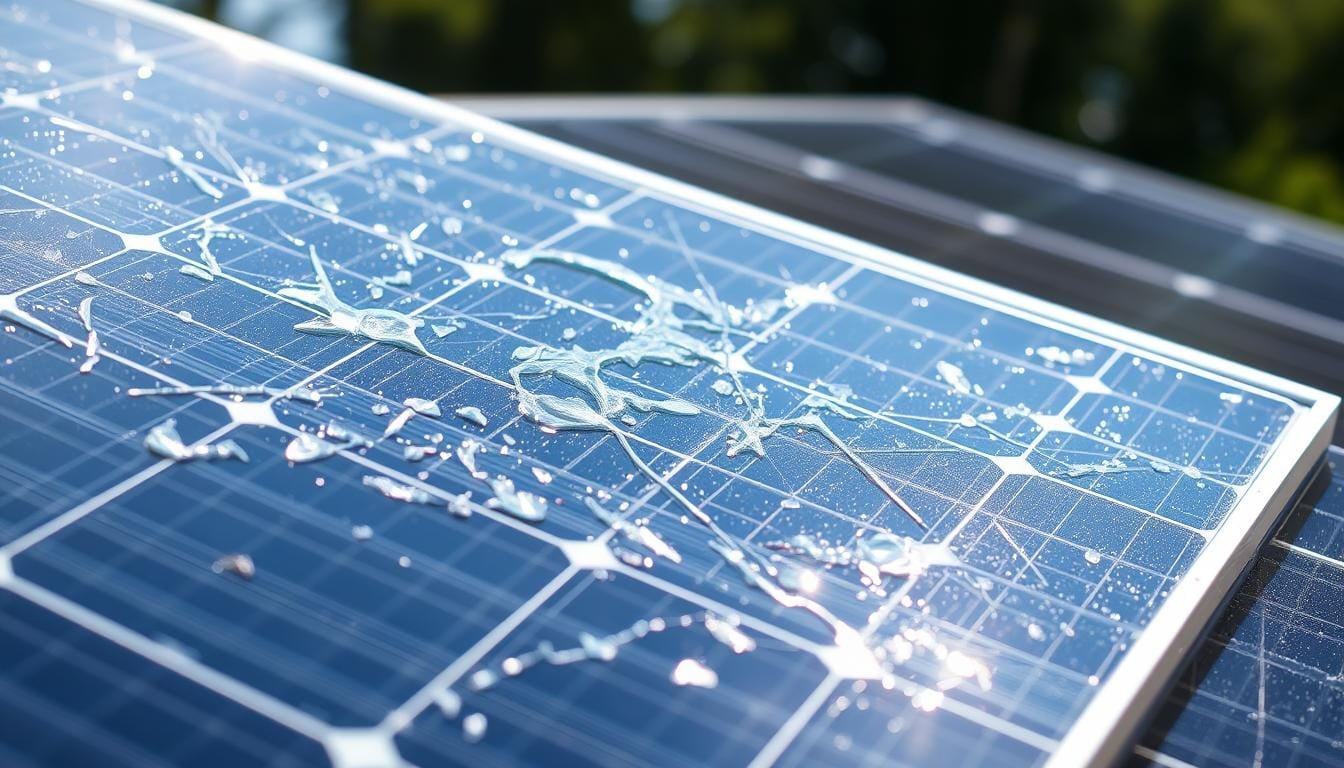Hailstorms can hit at speeds up to 75 mph, putting your solar panels at risk. These storms are a big threat to solar installations in the U.S. Places like Utah and Idaho see hailstorms often.
Solar panels can get damaged by hail, which worries homeowners. Even though modern panels are tough, they can’t handle extreme weather. It’s smart to know the risks and protect your solar system.
Checking for hail damage on solar panels is key. The panels’ strength depends on their material, how well they resist impacts, and where they’re placed. Experts say to watch your system’s for signs of damage.
Key Takeaways
- Hailstorms can travel at speeds up to 75 mph
- Modern solar panels are designed to last 25 years
- No solar panel is completely “hail-proof”
- Regular system monitoring is critical
- Strategic panel placement can lower hail damage risks
Understanding the Impact of Hail on Solar Panels
Solar panels are tough, but they can’t avoid all natural challenges. Hail can really hurt solar energy in areas with bad weather.
Hailstones are a big problem for solar panels. Their size and speed can cause different levels of harm. Most solar panels can handle normal hail, but really bad weather can hurt them a lot.
What Happens During a Hail Strike?
When hail hits solar panels, a few things can happen:
- Surface scratches and cosmetic damage
- Micro-cracks in solar cells
- Potential reduction in energy output
- Structural weakening of panel components
Identifying Hail Damage Signs
Finding hail damage needs a close look. Solar panel hail protection starts with knowing how to spot damage:
- Visible dents or chips on panel surface
- Hairline fractures in glass covering
- Unexpected drops in energy production
- Discoloration or clouding of panel surface
Damage Severity Breakdown
The damage from hail depends on the hailstones. Hailstones moving 10-75 mph can really hurt panels. If 15% of solar cells are damaged, the panel’s efficiency can fall by 15%.
After bad weather, getting a pro to check your panels is key. It helps keep your solar investment working well.
Types of Hail Damage We Should Look For
Protecting your solar investment means understanding the damage hailstorms can cause. Our guide will help you spot and assess different types of hail damage to your solar panels.
Hail can damage solar panel systems in many ways. Spotting these issues early can prevent long-term damage and expensive replacements.
Cracks in Solar Panels
Microcracks are a serious form of hail damage. These small fractures can reduce your solar panel’s efficiency over time. Panels are tested for hail resistance, but real impacts can cause damage.
- Hairline fractures may be invisible to the naked eye
- Potential efficiency loss of up to 2-3% per year
- Can lead to hot spots and further panel degradation
Dents and Dings on the Surface
Checking for hail damage is key. Dents in the metal frame or glass surface can weaken your solar panels.
| Damage Type | Potential Impact | Recommended Action |
|---|---|---|
| Small Dents | Minor efficiency reduction | Professional inspection |
| Deep Dents | Significant performance loss | Panel replacement |
Damage to Mounting Systems
Repairing hail-damaged solar panels involves more than just the panels. The mounting system can also be damaged, affecting the whole system’s stability.
“A single weak point in your solar installation can compromise the entire system’s performance and safety.” – Solar Energy Expert
If you think your panels have been damaged by hail, get a professional to check them. Replacing a damaged panel usually costs under $1,000. It’s a small price for keeping your solar system running well.
Assessing the Extent of Damage
Hailstorms can cause a lot of damage to solar panels. It’s important to know how to check for damage well. Our guide will show you how to spot and document hail damage on solar panels.
DIY Damage Evaluation Techniques
When checking for hail damage on solar panels, safety is key. Here are some steps to take from the ground:
- Check system performance data for unusual output drops
- Look for visible cracks or dents from a safe distance
- Use binoculars to inspect panel surfaces without climbing
When to Call a Professional
Some damage needs a pro to check. Solar technicians can spot issues you might miss. The cost of fixing damaged panels can vary, so getting a pro’s opinion is important.
| Damage Severity | Professional Assessment Recommended |
|---|---|
| Micro-cracks detected | Yes |
| Performance drop over 15% | Yes |
| Visible surface damage | Yes |
Documenting Damage for Insurance Claims
Good documentation is key for insurance claims on solar panel damage. Capture detailed evidence by:
- Taking clear, high-resolution photographs of damage
- Recording system performance data before and after the storm
- Obtaining a professional damage assessment report
Pro tip: Most insurance policies require detailed documentation for hail damage claims.
Safety Precautions After Hailstorms
When a hailstorm hits, it’s key to protect your solar arrays. Our guide will show you how to stay safe and protect your solar panels from hail.
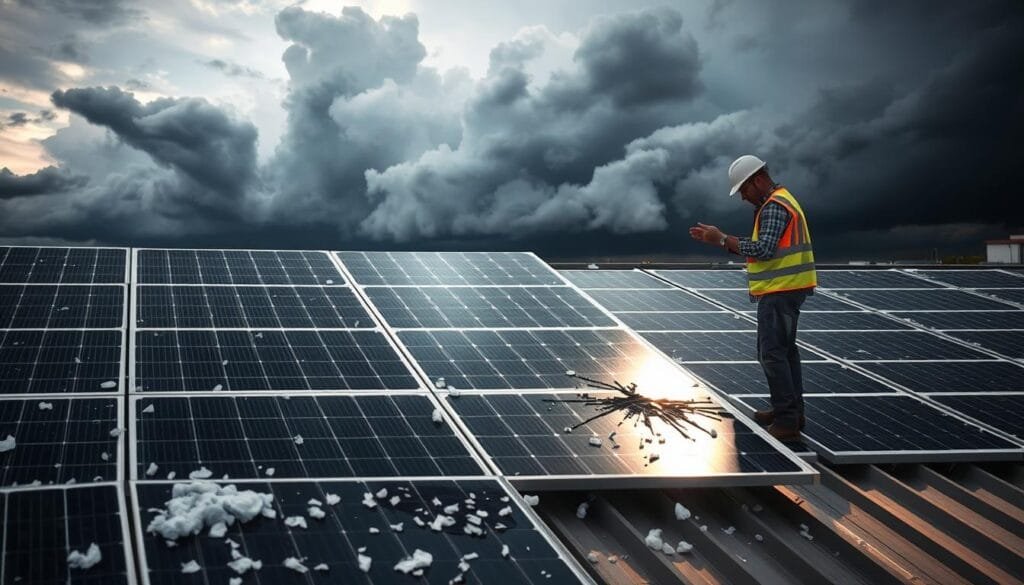
Right after a hailstorm, it’s vital to take quick safety steps. Most solar panels can handle moderate hail impacts. But, it’s important to check them carefully.
Avoiding Electrical Hazards
Damaged solar panels can be very dangerous. Here are some important safety tips:
- Disconnect the solar system from the main power grid
- Do not touch panels with visible cracks or damage
- Look for exposed wiring or compromised mounting systems
- Wear protective rubber-soled shoes when inspecting panels
Protecting Your Property
To avoid more damage, take these steps:
- Cover exposed panel areas with waterproof tarps
- Remove debris that might cause additional scratching
- Check surrounding roof structures for possible water intrusion
Temporary Solutions to Minimize Risk
Quick actions can help avoid long-term damage to your solar investment. Here are some temporary fixes:
- Use protective covers designed for solar panel hail protection
- Install temporary scaffolding or protective shields
- Contact your solar installer for professional emergency assessment
Remember, panels rated UL 61730 can usually handle hail up to 3 inches at 88.3 mph. But, it’s always best to have a pro check them after a big storm.
Insurance Considerations for Hail Damage
Dealing with solar panel insurance claims for hail damage can be tough for homeowners. Hail causes over 50% of solar claims costs. Knowing your insurance coverage is key. The average solar hail claim is now $58.4 million, showing how important it is to have the right protection.
Understanding Your Coverage
Not all insurance policies are the same when it comes to solar panels. Homeowners need to check their coverage carefully. Important things to look at include:
- Coverage for roof-mounted solar panels
- Protection for ground-mounted installations
- Specific clauses related to hail damage
Filing a Claim: Step-by-Step Guide
Here’s what to do when you have hail-damaged solar panels:
- Take clear photos of all damage
- Call your insurance right away
- Get a professional to assess the damage
- Collect all maintenance and installation records
What to Expect from Your Insurer
Insurance claims for solar panel hail damage can differ. Here’s a general idea of what to expect:
| Claim Stage | Typical Timeframe | Key Considerations |
|---|---|---|
| Initial Report | 1-3 days | Immediate damage documentation |
| Professional Assessment | 5-10 days | Detailed damage evaluation |
| Claim Processing | 2-4 weeks | Review of coverage and damage extent |
| Settlement | 30-60 days | Final compensation determination |
Pro tip: See if your policy covers solar panel replacements. Or if you need a special rider to protect your investment.
Repair vs. Replacement: What We Need to Know
When hail hits your solar panels, choosing between repair and replacement is tough. Our guide will help you make this important decision. We’ll look at the key factors to consider.
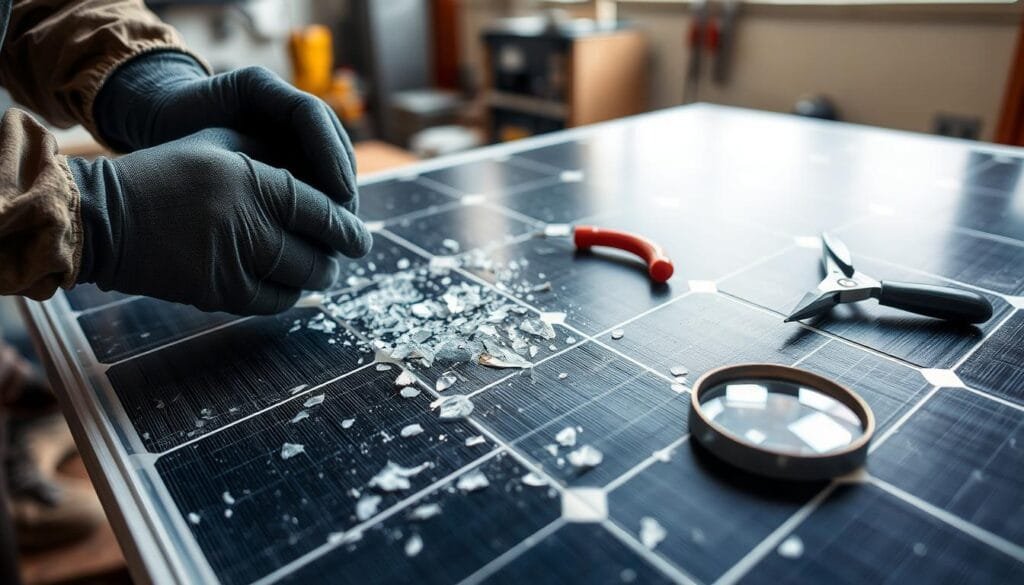
Factors Influencing Repair Decisions
Solar panel damage can be complex. We suggest looking at a few important things:
- How bad the damage is
- How old the panels are and how well they work
- How much the energy output might drop
- What the repair costs might be
When Replacement Becomes Necessary
Some situations call for replacing the solar panels:
- If more than 15% of the solar cells are damaged
- If there are visible cracks that could harm the panel
- If the panel’s performance drops more than usual
- If the panels are over 20-25 years old
Cost Analysis: Repair vs. Replacement
The cost to replace hail-damaged solar panels varies. Small repairs usually cost less than $1,000. But, replacing the whole system can cost a lot more, depending on the size and complexity.
*”Regular inspections can help identify hidden damage and maintain optimal solar panel performance.”*
We advise talking to a professional solar technician. They can give you a detailed look at your situation. They’ll help decide if fixing the panels is better than replacing them.
Choosing a Professional for Repairs
Fixing hail-damaged solar panels needs skill and care. The right contractor can greatly help in fixing your solar investment and avoiding future damage.
When picking a pro for solar panel repairs, look at a few key things. This ensures quality work and the best results.
Key Qualifications to Seek in a Solar Repair Contractor
- Certified solar panel repair specialists
- Proven experience with hail damage restoration
- Manufacturer-specific training credentials
- Positive customer reviews and references
Essential Questions to Ask a Contractor
- What specific experience do you have with hail damage repairs?
- Are you certified by major solar panel manufacturers?
- What warranty do you offer on repair work?
- Can you provide a detailed repair estimate?
Ensuring Quality and Warranty Protection
Our research shows replacing a damaged solar panel costs under $1,000. It’s important to document damage and pick a trusted contractor for good repairs.
Professional repairs can prevent efficiency losses and possible long-term electrical system risks.
| Repair Aspect | Typical Duration | Average Cost |
|---|---|---|
| Solar Panel Removal | 1 day | $200-$500 |
| Panel Replacement | 2-3 days | $500-$1000 |
| Electrical System Check | Half day | $150-$300 |
Choosing a skilled professional protects your solar investment. It also ensures your system works well after hail damage.
Preventive Measures Against Hail Damage
Protecting solar arrays from hail damage needs a smart plan. About 40% of solar claims are from severe storms. Our guide shows how to keep your solar investment safe.
Choosing hail-resistant solar panels is key. New solar tech protects well against bad weather. Solar modules with tempered glass are twice as strong as others.
Protective Systems and Strategies
- Install wire gauge mesh barriers that let sunlight in but block hail
- Apply methacrylate protective spray for a cheap way to shield surfaces
- Look into flexible solar panels that can handle impacts better
- Use community storm shelters for solar panels
Maintenance: Your Proactive Shield
Regular upkeep is vital to avoid hail damage. Checking for small cracks early can prevent big problems. Solar panels rated UL 61730 can handle hail up to 3 inches in diameter, moving at 88.3 miles per hour.
Geographic Considerations
Knowing your local weather is key. Places like Texas, Oklahoma, and Nebraska get big storms often. With the right protection, we can reduce damage and keep solar panels working well.
Case Studies: Real-Life Hail Damage Scenarios
Solar panels can get damaged by hail, affecting homes and businesses. Looking at real cases helps us learn how to deal with this problem.
In southeast Texas, the Fighting Jays solar project faced a big hailstorm. It hit about 350 MW of solar equipment. This shows how solar setups can be at risk during bad weather.
Lessons Learned from Residential Incidents
A study from the National Renewable Energy Laboratory (NREL) in Colorado is inspiring. In May 2017, a severe hailstorm hit. Yet, only one out of 3,168 solar panels was damaged. This shows the value of smart panel design and placement.
- Proper panel angle can significantly reduce hail damage risk
- Panels stowed at 75-degree angles showed near-zero damage probability
- Modern panels can withstand hailstones up to 1 inch in diameter
Commercial Installations at Risk
Big commercial solar projects face big risks from hail. The Prospero 1 and Prospero 2 farms in West Texas got hit by hailstones up to 3 inches. This caused a lot of damage to panels.
How Others Have Recovered
Here are some ways to recover from hail damage:
- Do a quick damage check
- Get a pro to inspect
- File an insurance claim
- Plan to replace or fix panels
Places like Tornado Alley in the Midwest and Oklahoma are at high risk. It’s important to watch the weather, keep panels in good shape, and know the local weather patterns to avoid big losses.
Building Awareness on Solar Safety
Solar panel hail protection starts with knowledge and community action. We know how important it is to teach homeowners how to prevent hail damage. This is done through wide-reaching awareness efforts.
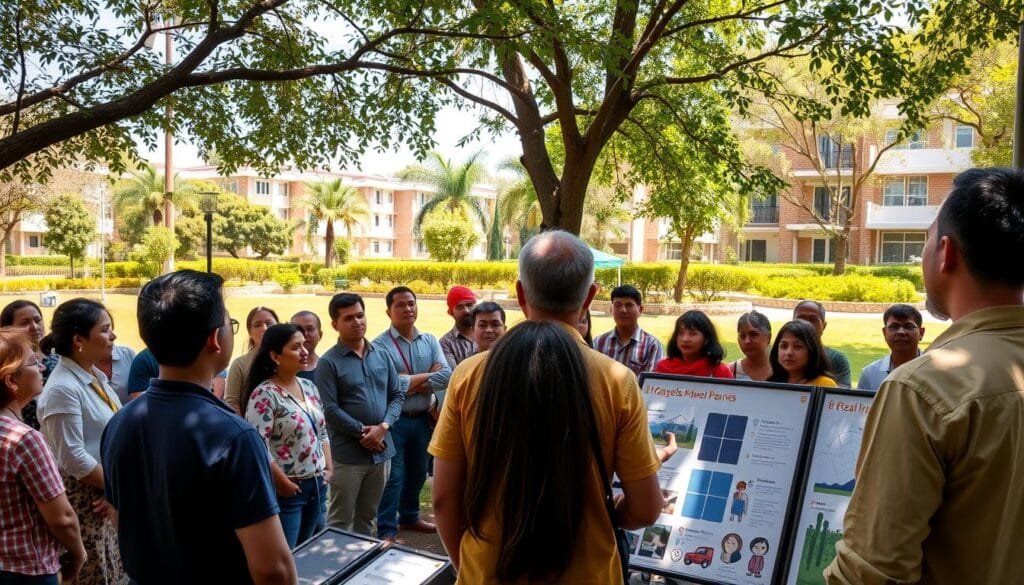
Protecting solar investments needs a broad approach. This approach gives homeowners the tools and knowledge they need.
Community Education Initiatives
We work hard to spread the word about solar panel safety. Our efforts include:
- Hosting local workshops on solar panel maintenance
- Creating online webinars about hail damage prevention
- Developing informational brochures for homeowners
- Organizing neighborhood solar safety seminars
Collaborating with Local Experts
We team up with solar technicians, meteorologists, and insurance pros. Together, we share the best ways to protect solar panels from hail.
Knowledge is the first line of defense against solar array damage.
Resources for Homeowners
We give homeowners the tools they need to protect their solar panels. This includes:
- Comprehensive online guides for solar panel maintenance
- Local expert contact directories
- Weather alert tracking systems
- Insurance claim navigation support
Preventing hail damage to solar arrays requires ongoing education, proactive maintenance, and community collaboration.
The Role of Technology in Damage Prevention
Solar technology is getting better, with new ways to protect solar panels from hail. We see big steps forward in how to handle severe weather. Smart tech is changing how we protect solar panels from hail.
Today’s solar panels have new, strong features to prevent damage. These include:
- Advanced tempered glass materials
- Smart tracking systems for storm positioning
- Automated damage monitoring platforms
- Enhanced durability certifications
Advancements in Hail-Resistant Materials
Now, solar panels are made to be very tough. They must pass tests with hailstones up to 25mm. Some panels can even handle hail at 83 km/hr, giving great protection against bad weather.
The Future of Solar Panel Design
New tech is making solar panels even safer. Smart tracking platforms like ARRAY’s SmarTrack™ can move panels to safe spots before storms hit. This helps keep panels working well, even in bad weather.
Smart Solutions to Monitor Damage
Now, we can check solar panels for damage right away. Systems can spot small cracks and changes in how they work. This lets owners fix problems early, keeping panels running smoothly.
Best Practices for Solar Panel Maintenance
Keeping your solar panels in top shape is key. This means taking steps to prevent hail damage. Regular checks and care ensure your solar system works well.
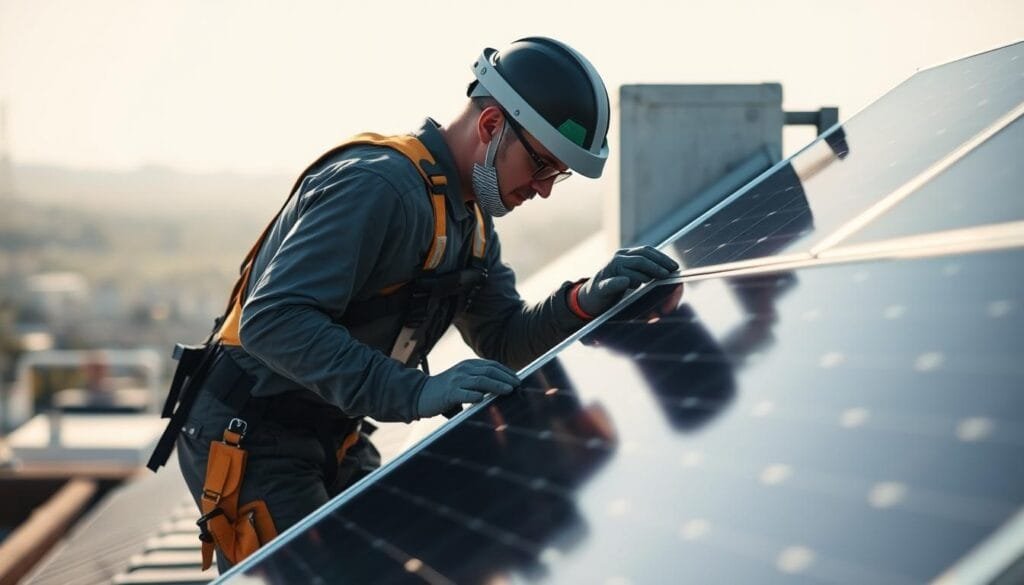
We focus on early action to protect your panels. This approach helps them last longer and withstand harsh weather. Regular checks can prevent big problems later on.
Seasonal Inspection Protocols
It’s smart to inspect your panels twice a year. After big weather events, check them too. Look for:
- Panel surface integrity
- Mounting system stability
- Electrical connection points
- Signs of hail damage
Cleaning and Care Techniques
Clean panels are essential for good performance. Professional cleaning two to four times a year keeps them efficient. Use soft brushes and gentle cleaners to avoid damage.
Prompt Repair of Minor Issues
Fixing small problems fast stops bigger issues. The Department of Energy says most panels can handle extreme weather. But, fixing small scratches or dents is vital for protection.
Proactive maintenance is the key to long-lasting solar panel performance.
Our data shows well-kept panels can stay efficient for 10 years. With warranties from 10 to 25 years, regular maintenance is worth it.
Understanding Local Weather Patterns
Solar panel owners need to watch local weather closely to protect their investment. Weather can greatly affect how well solar panels work. It can also cause damage from hail.
The United States has many different weather patterns. These can change how solar panels perform. Knowing the weather in your area is key to keeping your solar panels safe.
Areas Most Affected by Hail
Hail risks change from place to place. Some areas get hit by hail storms more often. The Tornado Alley region, including Texas, Oklahoma, Kansas, and Nebraska, is very risky for solar panels.
- Texas: Highest frequency of severe hailstorms
- Oklahoma: Significant hail risk throughout spring and summer
- Kansas: Regular hail events with large ice pellets
- Nebraska: Consistent hail threat during storm seasons
Seasonal Preparation Tips
To protect solar panels from hail, you need a plan. Here are some important steps to take:
- Install panels at steeper angles to reduce direct hail impact
- Consider protective barriers or specialized hail-resistant covers
- Conduct regular inspections after severe weather events
- Maintain complete insurance coverage
Resources for Weather-Related Alerts
It’s important to know when bad weather is coming. This helps prevent damage from hail. Use local weather services, apps, and community alerts for updates.
In a 2017 Denver hailstorm, only one solar panel out of over 3,000 was damaged. This shows how strong modern solar panels are.
Studies show solar panels can handle hail up to 1 inch in diameter. But, hail bigger than that can slowly reduce their performance.
Community Support and Resources
Dealing with hail damage on solar panels can be tough. But, you’re not alone. Our community has strong support systems to help you fix hail-damaged solar panels.
Finding the right resources can really help. We’ve found important support channels for you:
Local Organizations Providing Assistance
- State renewable energy associations
- Solar installation professional networks
- County emergency management offices
- Insurance provider support groups
Online Forums for Sharing Experiences
Online platforms are full of useful tips for solar panel damage. Here are some great places to find help:
- Reddit’s r/Solar subreddit
- Professional LinkedIn solar energy groups
- Facebook solar enthusiast communities
- Specialized renewable energy forums
Creating a Support Network for Homeowners
Having a strong support network is key when dealing with hail damage. Proactive communication with local solar pros, insurance agents, and other homeowners is vital. It offers both emotional and practical support during repairs.
Every hail damage case is different. Getting professional advice and sharing your story can guide you in fixing your solar panels. It helps protect your investment in renewable energy.
Evaluating the Environmental Impact of Damage
Solar energy is key to sustainable power. But hail is a big problem for solar panels. Our study looks at how severe weather affects renewable energy systems.
- Hailstorms can cut solar panel efficiency a lot
- Small cracks from hail can slowly lower energy output
- Big damage might mean panels need to be replaced
How Hail Affects Solar Energy Production
Studies show hail-cracked panels lose less than 4% energy. But, even this small loss is a big deal. Big hail can break solar panel glass, stopping energy production.
The Role of Renewable Energy in Severe Weather
Protecting solar panels from hail is more important than ever. The solar industry is working on new ways to make panels stronger. They test panels with ice balls to make them last longer.
Community-wide Benefits of Solar Adaptation
Strong solar systems are good for the environment. They help keep energy flowing, even when it’s hard. Our work on new tech keeps solar energy strong.
The future of solar energy depends on our ability to protect and optimize renewable infrastructure against environmental challenges.
Conclusion: Staying Informed and Prepared
Knowing how hail can harm solar panels is key to protecting our green energy. Only 0.1% of solar systems get damaged by hail each year. Our research shows that being ready can greatly reduce damage from bad weather.
To stop hail damage, we need to act early. Using hail-resistant panels and installing guards can help. Keeping up with maintenance and warranties is also important. Regular checks and keeping records help keep systems working well and covered by insurance.
Our study shows that new solar tech makes panels stronger. The National Renewable Energy Laboratory found most panels can handle a lot of impact. By keeping up with new tech and knowing our local weather, we can make our solar systems last longer and work better.
We’re dedicated to solar energy and always learning. By sharing knowledge, improving tech, and taking care of our systems, we can make solar energy more reliable. This way, we can face tough weather and keep our energy green and strong.

